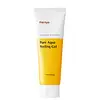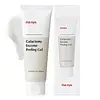What's inside
What's inside
 Key Ingredients
Key Ingredients

 Benefits
Benefits

 Concerns
Concerns

 Ingredients Side-by-side
Ingredients Side-by-side

Water
Skin ConditioningCellulose
AbsorbentDipropylene Glycol
HumectantBetaine
Humectant1,2-Hexanediol
Skin ConditioningGlycerin
HumectantSodium Hyaluronate
HumectantCalendula Officinalis Flower Extract
MaskingCeramide NP
Skin ConditioningZea Mays Starch
AbsorbentGluconolactone
Skin ConditioningInula Britannica Flower Extract
Skin ConditioningNelumbium Speciosum Flower Extract
Skin ConditioningButylene Glycol
HumectantHydrolyzed Hyaluronic Acid
HumectantSodium Acetylated Hyaluronate
HumectantPolyglyceryl-10 Laurate
Skin ConditioningPolyglyceryl-10 Myristate
Skin ConditioningGlyceryl Caprylate
EmollientEthylhexylglycerin
Skin ConditioningCaprylyl Glycol
EmollientHydrogenated Lecithin
EmulsifyingPhytosteryl/Octyldodecyl Lauroyl Glutamate
Skin ConditioningCaprylic/Capric Triglyceride
MaskingGardenia Florida Fruit Extract
Skin ConditioningSodium Carbomer
Emulsion StabilisingMaltodextrin
AbsorbentJasminum Officinale Oil
MaskingCananga Odorata Flower Oil
MaskingWater, Cellulose, Dipropylene Glycol, Betaine, 1,2-Hexanediol, Glycerin, Sodium Hyaluronate, Calendula Officinalis Flower Extract, Ceramide NP, Zea Mays Starch, Gluconolactone, Inula Britannica Flower Extract, Nelumbium Speciosum Flower Extract, Butylene Glycol, Hydrolyzed Hyaluronic Acid, Sodium Acetylated Hyaluronate, Polyglyceryl-10 Laurate, Polyglyceryl-10 Myristate, Glyceryl Caprylate, Ethylhexylglycerin, Caprylyl Glycol, Hydrogenated Lecithin, Phytosteryl/Octyldodecyl Lauroyl Glutamate, Caprylic/Capric Triglyceride, Gardenia Florida Fruit Extract, Sodium Carbomer, Maltodextrin, Jasminum Officinale Oil, Cananga Odorata Flower Oil
Galactomyces Ferment Filtrate 24.8%
HumectantHydrolyzed Collagen Extract
Skin ProtectingSqualane
EmollientCetearyl Alcohol
EmollientGlycerin
HumectantCaprylic/Capric Triglyceride
MaskingPropanediol
Solvent1,2-Hexanediol
Skin ConditioningNiacinamide
SmoothingPhaseolus Radiatus Seed Water
Hamamelis Virginiana Water
AstringentOryza Sativa Bran Water
MaskingRosa Centifolia Flower Water
Skin ConditioningPolyglyceryl-6 Stearate
EmollientPanthenol
Skin ConditioningCentella Asiatica Extract
CleansingGlycyrrhiza Uralensis Root Extract
Skin ConditioningSaccharomyces Ferment Filtrate
HumectantDioscorea Japonica Root Extract
Skin ConditioningSalix Alba Bark Extract
AstringentSimmondsia Chinensis Seed Oil
EmollientBetaine
HumectantCentella Asiatica Leaf Extract
Skin ConditioningMangifera Indica Seed Butter
Skin ConditioningPolyglyceryl-2 Stearate
EmulsifyingGlyceryl Stearate
EmollientStearyl Alcohol
EmollientLaminaria Japonica Extract
Skin ProtectingCassia Italica Leaf Extract
Skin ConditioningRosmarinus Officinalis Leaf Extract
AntimicrobialChamomilla Recutita Flower Extract
MaskingCamellia Sinensis Leaf Extract
AntimicrobialSh-Oligopeptide-1
Skin ConditioningSh-Oligopeptide-2
Skin ConditioningSh-Polypeptide-1
Skin ConditioningSh-Polypeptide-2
Skin ConditioningSodium Hyaluronate
HumectantPolygonum Cuspidatum Root Extract
AntioxidantScutellaria Baicalensis Root Extract
AstringentEthylhexylglycerin
Skin ConditioningMacadamia Integrifolia Seed Oil
Skin ConditioningPropanediol Dicaprylate
EmollientBeta-Glucan
Skin ConditioningHydrogenated Olive Oil Unsaponifiables
EmollientEnantia Chlorantha Bark Extract
Skin ConditioningOleanolic Acid
Skin ConditioningPolyglyceryl-6 Behenate
Emulsion StabilisingAcanthopanax Senticosus Root Extract
Skin ConditioningGlutathione
Maltodextrin
AbsorbentHydrolyzed Avocado Protein
Skin ConditioningTrehalose
HumectantGlyceryl Caprylate
EmollientCeramide NP
Skin ConditioningCarnosine
Skin ConditioningViscum Album Extract
Skin ConditioningRosa Damascena Flower Oil
MaskingRose Flower Oil
MaskingAdenosine
Skin ConditioningGalactomyces Ferment Filtrate 24.8%, Hydrolyzed Collagen Extract, Squalane, Cetearyl Alcohol, Glycerin, Caprylic/Capric Triglyceride, Propanediol, 1,2-Hexanediol, Niacinamide, Phaseolus Radiatus Seed Water, Hamamelis Virginiana Water, Oryza Sativa Bran Water, Rosa Centifolia Flower Water, Polyglyceryl-6 Stearate, Panthenol, Centella Asiatica Extract, Glycyrrhiza Uralensis Root Extract, Saccharomyces Ferment Filtrate, Dioscorea Japonica Root Extract, Salix Alba Bark Extract, Simmondsia Chinensis Seed Oil, Betaine, Centella Asiatica Leaf Extract, Mangifera Indica Seed Butter, Polyglyceryl-2 Stearate, Glyceryl Stearate, Stearyl Alcohol, Laminaria Japonica Extract, Cassia Italica Leaf Extract, Rosmarinus Officinalis Leaf Extract, Chamomilla Recutita Flower Extract, Camellia Sinensis Leaf Extract, Sh-Oligopeptide-1, Sh-Oligopeptide-2, Sh-Polypeptide-1, Sh-Polypeptide-2, Sodium Hyaluronate, Polygonum Cuspidatum Root Extract, Scutellaria Baicalensis Root Extract, Ethylhexylglycerin, Macadamia Integrifolia Seed Oil, Propanediol Dicaprylate, Beta-Glucan, Hydrogenated Olive Oil Unsaponifiables, Enantia Chlorantha Bark Extract, Oleanolic Acid, Polyglyceryl-6 Behenate, Acanthopanax Senticosus Root Extract, Glutathione, Maltodextrin, Hydrolyzed Avocado Protein, Trehalose, Glyceryl Caprylate, Ceramide NP, Carnosine, Viscum Album Extract, Rosa Damascena Flower Oil, Rose Flower Oil, Adenosine
 Reviews
Reviews

Alternatives
Ingredients Explained
These ingredients are found in both products.
Ingredients higher up in an ingredient list are typically present in a larger amount.
1,2-Hexanediol is a synthetic liquid and another multi-functional powerhouse.
It is a:
- Humectant, drawing moisture into the skin
- Emollient, helping to soften skin
- Solvent, dispersing and stabilizing formulas
- Preservative booster, enhancing the antimicrobial activity of other preservatives
Betaine is a common humectant (a substance that promotes retention of moisture). It's known to be gentle on the skin and can help balance hydration.
This ingredient is best for improving hydration and soothing irritated skin. Studies also show it helps even out skin tone.
Fun fact: Betaine is naturally created in the skin and body. The kind found within cosmetic products can be either plant-derived or synthetic.
Another name for betaine is trimethylglycine.
Learn more about BetaineThis ingredient is an emollient, solvent, and texture enhancer. It is considered a skin-softener by helping the skin prevent moisture loss.
It helps thicken a product's formula and makes it easier to spread by dissolving clumping compounds.
Caprylic Triglyceride is made by combining glycerin with coconut oil, forming a clear liquid.
While there is an assumption Caprylic Triglyceride can clog pores due to it being derived from coconut oil, there is no research supporting this.
Learn more about Caprylic/Capric TriglycerideCeramide NP is a type of ceramide and formally known as ceramide 3.
Ceramides are intercellular lipids naturally found in our skin that bonds dead skin cells together to create a barrier. They are known for their ability to hold water and thus are a great ingredient for dry skin.
Ceramides are an important building block for our skin barrier. A stronger barrier helps the skin look more firm and hydrated. By bolstering the skin ceramides act as a barrier against irritating ingredients. This can help with inflammation as well.
If you would like to eat ceramides, sweet potatoes contain a small amount.
Read more about other common types of ceramides here:
Ceramide AP
Ceramide EOP
Ethylhexylglycerin (we can't pronounce this either) is commonly used as a preservative and skin softener. It is derived from glyceryl.
You might see Ethylhexylglycerin often paired with other preservatives such as phenoxyethanol. Ethylhexylglycerin has been found to increase the effectiveness of these other preservatives.
Glycerin is already naturally found in your skin. It helps moisturize and protect your skin.
A study from 2016 found glycerin to be more effective as a humectant than AHAs and hyaluronic acid.
As a humectant, it helps the skin stay hydrated by pulling moisture to your skin. The low molecular weight of glycerin allows it to pull moisture into the deeper layers of your skin.
Hydrated skin improves your skin barrier; Your skin barrier helps protect against irritants and bacteria.
Glycerin has also been found to have antimicrobial and antiviral properties. Due to these properties, glycerin is often used in wound and burn treatments.
In cosmetics, glycerin is usually derived from plants such as soybean or palm. However, it can also be sourced from animals, such as tallow or animal fat.
This ingredient is organic, colorless, odorless, and non-toxic.
Glycerin is the name for this ingredient in American English. British English uses Glycerol/Glycerine.
Learn more about GlycerinGlyceryl Caprylate comes from glycerin and caprylic acid, a fatty acid from coconut. It has emollient and emulsifier properties.
As an emollient, it helps hydrate your skin. Emollients work by creating a barrier on your skin to trap moisture in, helping to keep your skin soft and smooth.
On the other hand, emulsifiers prevent ingredients (such as oil and water) from separating.
Learn more about Glyceryl CaprylateMaltodextrin is a polysaccharide. It is derived from starch such as rice, corn, wheat, or potato starch.
In food, Maltodextrin is used to improve the texture and thicken a product. Due to its structure, it can help create a gel texture. As an emulsion stabilizer, it helps keep the ingredients in a product together.
As a polysaccharide, Maltodextrin has moisturizing properties. Polysaccharides are a type of carbohydrate. The top layer of skin uses polysaccharides to retain water, keeping the skin hydrated.
Maltodextrin is water soluble and has a sweet taste.
Learn more about MaltodextrinSodium Hyaluronate is hyaluronic acid's salt form. It is commonly derived from the sodium salt of hyaluronic acid.
Like hyaluronic acid, it is great at holding water and acts as a humectant. This makes it a great skin hydrating ingredient.
Sodium Hyaluronate is naturally occurring in our bodies and is mostly found in eye fluid and joints.
These are some other common types of Hyaluronic Acid:
Learn more about Sodium Hyaluronate